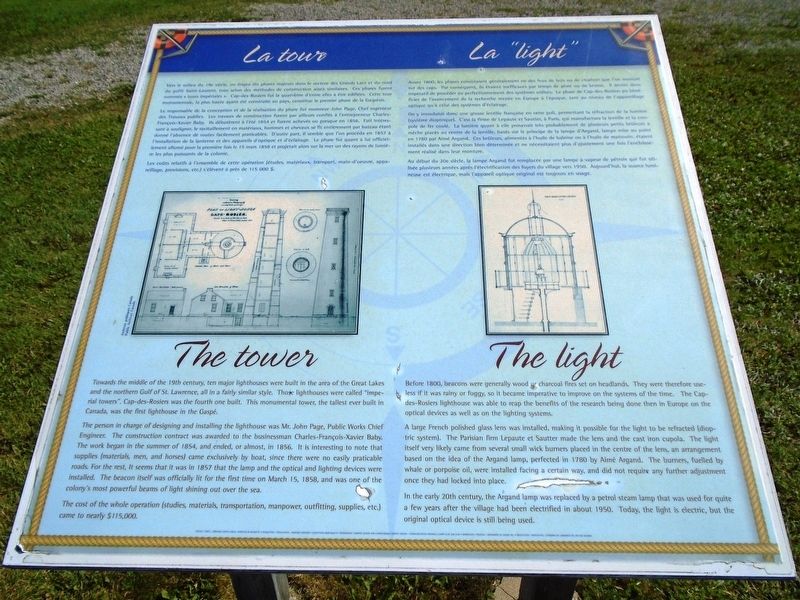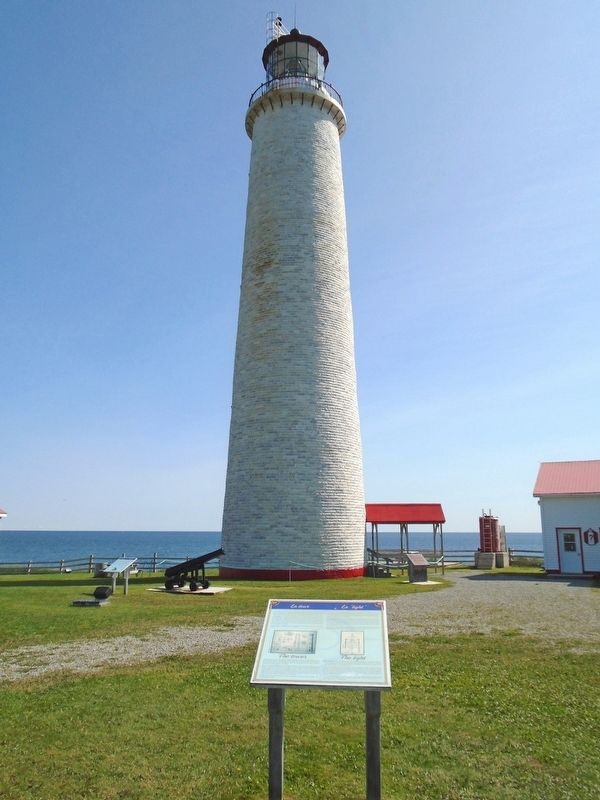La tour - La "light" / The tower - The light
La tour
Vers le milieu du 19e siècle, on érigea dix phares majeurs dans le secteur des Grands Lacs et du nord du golfe Saint-Laurent, tous selon des méthodes de construction assez similaires. Ces phares furent nommés « tours impériales ». Cap-des-Rosiers fut la quatrième d'entre elles à être édifiées. Cette tour monumentale, la plus haute ayant été construite au pays, constitue le premier phare de la Gaspésie.
Le responsable de la conception et de la réalisation du phare fut monsieur John Page, Chef ingénieur des Travaux publics. Les travaux de construction furent par ailleurs confiés à l'entrepreneur Charles-François-Xavier Baby. Ils débutèrent à l'été 1854 et furent achevés ou presque en 1856. Fait intéressant à souligner, le ravitaillement en matériaux, hommes et chevaux se fit entièrement par bateau étant donné l'absence de routes facilement praticables. D'autre part, il semble que l'on procéda en 1857 à l'installation de la lanterne et des appareils d'optique et d'éclairage. Le phare fut quant à lui officiellement allumé pour la première fois le 15 mars 1858 et projetait alors sur la mer un des rayons
de lumière les plus puissants de la colonie.Les coûts relatifs à l'ensemble de cette opération (études, matériaux, transport, main-d'oeuvre, appareillage, provisions, etc.) s'élèvent à près de 115 000 $.
La “light”
Avant 1800, les phares consistaient généralement en des feux de bois ou de charbon que l'on montait sur des caps. Par conséquent, ils étaient inefficaces par temps de pluie ou de brume. Il devint donc impératif de procéder au perfectionnement des systèmes utilisés. Le phare de Cap-des-Rosiers pu bénéficier de l'avancement de la recherche menée en Europe à l'époque, tant au niveau de l'appareillage optique qu'à celui des systèmes d'éclairage.
On y introduisit donc une grosse lentille française en verre poli, permettant la réfraction de la lumière (système dioptrique). C'est la firme de Lepaute et Sautter, à Paris, qui manufactura la lentille et la coupole de fer coulé. La lumière quant à elle provenait très probablement de plusieurs petits brûleurs à mèche placés au centre de la lentille, basés sur le principe de la lampe d'Argand, lampe mise au point en 1780 par Aimé Argand. Ces brûleurs, alimentés à l'huile de baleine ou à l'huile de marsouin, étaient installés dans une direction bien déterminée et ne nécessitaient plus d'ajustement une fois l'enchâssement réalisé dans leur monture.
Au début du 20e siècle, la lampe Argand
The person in charge of designing and installing the lighthouse was Mr. John Page, Public Works Chief Engineer. The construction contract was awarded to the businessman Charles-Françoise-Xavier Baby. The work began in the summer of 1854, and ended, or almost, in 1856. It is interesting to note that supplies (materials, men, and horses) came exclusively by boat, since there were no easily praticable [? - navigable?] roads. For the rest, [i]t seems that it was in 1857 that the lamp and the optical and lighting devices were installed. The beacon itself was officially lit for the first time on March 15, 1858, and was one of the colony's most powerful beams of light shining out over the sea.
The cost of the whole operation (studies, materials,
The light
A large French polished glass lens was installed, making it possible for the light to be refracted (dioptric system). The Parisian firm Lepaute et Sautter made the lens and the cast iron cupola. The light itself very likely came from several small wick burners placed in the centre of the lens, an arrangement based on the idea of the Argand lamp, perfected in 1780 by Aimé Argand. The burners, fuelled by whale or porpoise oil, were installed facing a certain way, and did not require any further adjustment once they had locked into place.
In the early 20th century, the Argand lamp was replaced by a petrol steam lamp that was used for quite a few years after the village had been electrified in about 1950. Today, the light is electric, but the original optical device is still being used.
Towards the middle of the 19th century, ten major lighthouses were built in the area of the Great Lakes and the northern Gulf of St. Lawrence, all in a fairly similar style. Those lighthouses were called "imperial towers". Cap-des-Rosiers was the fourth one built. This monumental tower, the tallest ever built in Canada, was the first lighthouse in the Gaspé.
Before 1800, beacons were generally wood or charcoal fires set on headlands. They were therefore useless if it was rainy or foggy, so it became imperative to improve on the systems of the time. The Cap-des-Rosiers lighthouse was able to reap the benefits of the research being done then in Europe on the optical devices as well as on the lighting systems.
Erected by Cap-des-Rosiers Lighthouse Maritime Historical Site.
Topics and series. This historical marker is listed in these topic lists: Charity & Public Work • Communications • Waterways & Vessels. In addition, it is included in the Lighthouses series list. A significant historical year for this entry is 1854.
Location. 48° 51.367′ N, 64° 12.1′ W. Marker is in Cap-des-Rosiers, Québec, in La Côte-de-Gaspé. Marker can be reached from Boulevard de Cap des Rosiers. Marker is on the grounds Cap-des-Rosiers Lighthouse Maritime Historical Site. Touch for map. Marker is at or near this postal address: 1325 Boulevard de Cap des Rosiers, Cap-des-Rosiers QC G4X 6G7, Canada. Touch for directions.
Other nearby markers. At least 7 other markers are within walking distance of this marker. Passer le cap / Keeping on course (a few steps from this marker); Gaspé, une ville au coeur de la découverte (within shouting distance of this marker); Le criard / Fog horn (within shouting distance of this marker); Le phare de Cap des Rosiers Lighthouse (within shouting distance of this marker); Cloche du "Carrick's" voilier Irlandais / Bell of the "Carrick's" Irish Sailboat (approx. 0.4 kilometers away); Carricks of Whitehaven Shipwreck Memorial (approx. 0.4 kilometers away); Hommages aux Anciens / Honoring Our Pioneers (approx. 0.8 kilometers away).
Also see . . .
1. Cap des Rosiers Lighthouse. Lighthouse Friends website entry (Submitted on February 12, 2019, by William Fischer, Jr. of Scranton, Pennsylvania.)
2. Lieu historique national du Canada du Phare-du-Cap-des-Rosiers. Parcs Canada website entry (Submitted on February 12, 2019, by William Fischer, Jr. of Scranton, Pennsylvania.)
Additional keywords. La tour - La "light" / The tower - The light
Credits. This page was last revised on December 2, 2023. It was originally submitted on February 12, 2019, by William Fischer, Jr. of Scranton, Pennsylvania. This page has been viewed 114 times since then and 16 times this year. Photos: 1, 2. submitted on February 12, 2019, by William Fischer, Jr. of Scranton, Pennsylvania.

